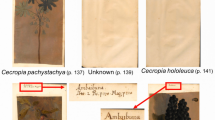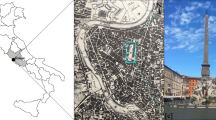Abstract
Relatively little research has been carried out in the field of iconography in ancient Roman sculpture and painting. Therefore, we have compiled a botanical database to define the qualitative and quantitative aspects of botanical elements found in archaeological structures, and to name taxa cited in ancient literary sources which are of uncertain identification. This includes data set of about 420 art works and 3,000 related images based on information found in ancient writers and new discoveries, which have emerged from the research process. 202 taxa of plants (78 families, 159 genera, and 168 species) have been identified to date, and the main characteristics of their floristic elements and their degree of rarity are reported. Acanthus mollis, Vitis vinifera, Phoenix dactylifera, Punica granatum, Ficus carica, Laurus nobilis, and Hedera helix proved to be the species represented most frequently, due to their strong association with mythological and religious symbolism. The database contains 97 (47.8 %) new or very recently identified species, representing almost half of the information currently available in academic literature; a large proportion of species represented in the artworks (70.0 %) seems to occur with very low frequency. A number of doubtful exotic taxa attributed to Pompeian gardens in some previous iconographic studies have probably been confused with native species. The database confirms the wide variety of botanical elements and their frequent recurrence in ancient Roman decorations. The ancients’ extensive knowledge of their natural surroundings is also confirmed, suggesting the need for a more wide-reaching cataloguing of archaeological structures.





Similar content being viewed by others
References
Amigues S (2002) Études de botanique antique. Académie des Inscriptions et Belles-Lettres, Paris
André J (2010) Les noms des plantes dans la Rome antique. Les Belles Lettres, Paris
Baumann H (1993) Greek wild flowers and plant lore in ancient Greece. Herbert Press, London
Bennett M (2011) The Pomegranate: marker of cyclical time, seeds of eternity. Int J Humanit Soc Sci 1(19):52–59
Bossi G, Allevato E, Caneva G et al (2010) The peach in Italy: archaeobotanical, historical and iconographical sources from Roman to Medieval age. Proceedings of 4th International Congress on “Science and Technology for the Safeguard of Cultural Heritage in the Mediterranean Basin”. Cairo, Egypt 6th–8th December 2009, Ferrari A (ed), Vol I: 370
Brosse J (1991) Mitologia degli alberi. Rizzoli, Milano
Caneva G (1992) Il mondo di Cerere nella Loggia di Psiche. Palombi, Roma
Caneva G (1999) Ipotesi sul significato simbolico del giardino della Villa di Livia (Prima Porta). Bull Comm Archaeol Comunale Roma 100:63–80
Caneva G (2010) The Augustus botanical code: Rome, Ara Pacis: speaking to the people through the images of nature. Gangemi, Roma
Caneva G, Bohuny L (2003) Botanic analysis of Livia’s villa painted flora (Prima Porta, Roma). J Cult Herit 4:149–155
Caneva G, Carpaneto GM (eds) (2011) Raffaello e l’immagine della natura. Silvana Editoriale, Cinisello Balsamo
Caneva G, Kumbaric A (2010) Plants in the ancient artistic representations as a tool of communication and a cultural message. Proceedings of 4th International Congress on “Science and Technology for the Safeguard of Cultural Heritage in the Mediterranean Basin”. Cairo, Egypt 6th–8th December 2009, Ferrari A. (ed), Vol. I: 255–259
Caneva G, Pacini E, Signorini MA, Merante A (2005) La fitoiconologia per il riconoscimento e l’interpretazione delle rappresentazioni artistiche. In: Caneva G (ed) La Biologia vegetale per i beni culturali, vol II. Nardini, Firenze, pp 85–128
Caneva G, Savo V, Kumbaric A (2014) Big messages in small details: nature in the Roman archaeology. Econ Bot (in press)
Casella D (1950) La Frutta nelle pitture pompeiane. Macchiaroli, Napoli
Castriota D (1995) The Ara Pacis Augustae and the imagery of abundance in later Greek and Roman imperial art. Princeton University Press, Princeton
Ciarallo AM (1991) Il giardino dipinto nella casa del Bracciale d’oro a Pompei e il suo restauro. Casa di risparmio di Firenze, Firenze
Ciarallo AM (1992) Orti e giardini della antica Pompei. Fausto Fiorentino, Napoli
Ciarallo AM (2000) Verde pompeiano. L’Erma di Bretschneider, Roma
Ciarallo AM (2004) Flora Pompeiana. L’Erma di Bretschneider, Roma
Ciarallo AM (2006) Elementi vegetali nell’iconografia pompeiana. L’Erma di Bretschneider, Roma
Comes O (1879) Enumerazione delle piante rappresentate nei dipinti pompeiani. In: Pompei e la regione sotterrata dal Vesuvio nell’anno LXXIX. Stab. Tip. Giannini, Napoli
Daunay MC, Janick J, Laterrot H (2007) Iconography of the Solanaceae from antiquity to the XVIIth century: a rich source of information on genetic diversity and uses. In: Spooner DM, Bohs L, Giovannoni J, Olmstead RG, Shibata D (eds) Solanaceae VI. Genomics meets biodiversity. Acta Hortic 745:59–88
Day LF (1892) Nature in Ornament. Charles Scribner’s sons, New York
De Cleen M, Lejeune MCl (2003) Compendium of Ritual Plants in Europe Vol. 1: Trees and Shrubs. Mens & cultuur uitgevers n.v., Ghent
Dierbach JH (1833) Flora mythologica oder in bezug auf mythologie und symbolik der Griechen und Römer. Ein Beitrag zur ältesten Geschichte der Botanik, Agricultur und Medicin, Frankfurt am Main
Fabre AJ (2003) Mythologie et plantes médicinales de l’Antiquité. Hist Sci Medic 37(1):65–87
Guarino R, Addamiano S, La Rosa M, Pignatti S (2010) “Flora Italiana Digitale”: An interactive identification tool for the Flora of Italy In: Nimis PL, Vignes Lebbe R (eds) “Tools for Identifying Biodiversity: Progress and Problems. Proceedings of the International Congress, Paris, EUT Edizioni Università di Trieste, Trieste 157–162
Harshberger JW (1896) The purposes of ethnobotany. Bot Gaz 21:146–154
Hehn V (1870) Kulturpflanzen und haustiere in ihrem uebergang aus Asien nach Griechenland und Italien. Gebrüder Borntraeger, Berlin
Janick J, Paris HS, Parrish DC (2007) The cucurbits of Mediterranean antiquity: identification of taxa from ancient images and descriptions. Ann Bot 100:1441–1457
Jashemski WF (1979) The gardens of Pompeii, Herculaneum and the villas destroyed by Vesuvius. Caratzas, New Rochelle
Jashemski WF, Meyer FG (2002) The natural history of Pompeii. Cambridge University Press, Cambridge
Jashemski WF, Meyer FG, Ricciadri M (2002) Catalogue of plants. In: Jashemski WF, Meyer FG (eds) The Natural History of Pompeii. Cambridge University Press, Cambridge
Kandeler R, Ullrich WR (2009) Symbolism of plants: examples from European-Mediterranean culture presented with biology and history art. J Exp Bot 60(15):4219–4220
Kumbaric A, Savo V, Caneva G (2012) Orchids in the Roman culture and iconography: evidence for the first representations in antiquity. J Cult Herit. doi:10.1016/j.culher.2012.09.002
Marcello A, Forlati Tamaro B (1959–1960) Smilax aspera lugubre pianta. Atti dell’Istituto Veneto di Scienze, Lettere ed Arti. CXVIII, 251–276
Mattirolo O (1911) I vegetali nell’Arte degli antichi e dei primitivi. Stamparia Reale GB Paravia e Comp, Torino
Meyer FS (1920) A handbook of ornament. 1st American ed. with three hundred plates, containing about three thousand illustrations of the elements, and the application of decoration to objects. Architectural book pub. Co, New York
Milella M (2010) La decorazione del tempio di Venere Genitrice. Scienze dell’antichità Storia Archeologia Antropologia 16:455–469
Möller M (1890) Die Botanik in den Fresken der Villa Livia. Mitt. Deutsch, Arch. Inst. Röm Abteilung 78–80
Penso G (1986) Le piante medicinali nell’arte e nella storia. Ciba Geigy, Milano
Settis S (2008) La villa di Livia. Le pareti ingannevoli, Mondadori Electa
Stoiculescu CD (1985) Trajan’s column documentary value from a forestry viewpoint. Dacia 29:81–98
Stolarczyk J, Janick J (2011) Carrot: history and iconography. Chron Hortic 51(2):13–18
Vandi L (2002) La trasformazione del motivo dell’acanto dall’antichità al XV secolo-Ricerche di teoria e storia dell’ornamento, XXII, Zahlr. Abb. Europäische Hochschulschriften, Reihe 28: Kunstgeschichte Vol. 386. Peter Lang, Bern
Acknowledgments
The authors wish to thank Angelo Merante for his help with the graphics. We also wish to thank the Soprintendenza Speciale per i Beni Archeologici di Roma and the Sovraintendenza Capitolina ai Beni Culturali of Roma Capitale, for their help in this study and for the granting of permission to take photographs in Museums.
Author information
Authors and Affiliations
Corresponding author
Rights and permissions
About this article
Cite this article
Kumbaric, A., Caneva, G. Updated outline of floristic richness in Roman iconography. Rend. Fis. Acc. Lincei 25, 181–193 (2014). https://doi.org/10.1007/s12210-013-0279-4
Received:
Accepted:
Published:
Issue Date:
DOI: https://doi.org/10.1007/s12210-013-0279-4




